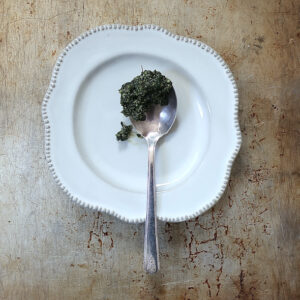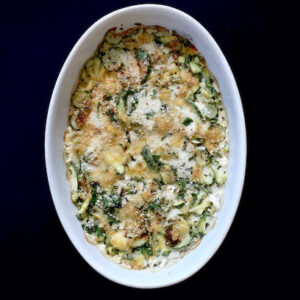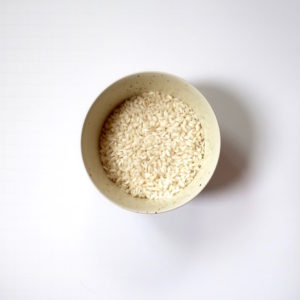Minestrone
For the non-Italian, deciding to prepare Minestrone can feel a little intimidating.

Minestrone itself–a substantial vegetable soup–isn’t difficult to make. The problem is deciding which minestrone to make. Elizabeth David, writing in Italian Cooking, gives five recipes for minestrone. In The Essentials of Italian Cooking, Marcella Hazan offers a recipe for the minestrone of her native Romagna, then gives a Milanese variation. I have several other Italian cookbooks on my shelves. I didn’t dare open them for fear of becoming paralyzed by indecision.

Joking aside, every recipe I consulted agreed that minestrone is always prepared with seasonal produce–lots of it. Marcella Hazan says minestrone should be “fairly dense,” rather than “thin and watery.”
From there, variations abound. There are minestrones with meat, meaning some kind cured pork product, and minestrones that are vegetarian. All minestrones call for a starchy element: dried or canned beans, pasta, rice. Some soups are made with water, while others use meat or other broths. I say “other” as Elizabeth David’s recipes call for “stock” without elaborating further.

Finally, there were minestrone variations calling for pesto. My recipe isn’t one of them.

Into the kitchen.
As noted, minestrone isn’t difficult to make, but it’s prep intensive. The vegetables need washing, trimming, and slicing. This takes time.

I chose rice for the starchy element.

A note on cleaning vegetables: Hazan recommends soaking zucchini (courgettes for my UK readers) in water before slicing them. I tried this and was amazed at amount of grit that floated out. The same water washed the green beans, then watered our plants.

When it comes to making the soup, Hazan adheres to the principle of insaporire, which translates to “bestowing taste.” Anyone who has patiently browned short ribs and deglazed the pan afterward whilst scraping up the fond will understand insaporire, and why it’s necessary to build a tasty soup.

Here, it means slowing cooking the onion (and garlic, if you opt to use it) in butter and olive oil until it becomes translucent. Only then do you add the carrots, and slowly cook them before adding the potatoes, and so on.

Minestrone is a meal in itself, meant to be served at room temperature with Parmesan cheese and bread.

Minestrone
[Italian Vegetable Soup]
I am indebted to Marcella Hazan’s Essentials of Classic Italian Cooking and Elizabeth David’s Italian Food.
Prep time: prep depends on how quickly you can wash and slice numerous vegetables. Give yourself a good hour. Cooking time is about 2.5 hours, largely unattended.
Minestrone may be prepared in a pressure cooker, Instant pot, or slow cooker.
You will need a lidded soup pot that will hold all the ingredients. If your soup pot doesn’t have a lid, tinfoil will work.
Servings: 4-5
Please read notes, below, before starting to cook.
Note that ingredient measurements/weights are given as a rough guide. Soup is forgiving, and the extra bit of potato or carrot will not ruin it.
butter and olive oil, for the pot
1 zucchini (courgette)
1/4 pound/60 grams green beans
1 small onion, or half of larger onion
1 carrot
approximately 1 cup/180 grams waxy potatoes
1/2 small cabbage, shredded
bay leaf
fresh thyme
Salt and pepper
2/3 cup/85 grams imported whole canned plum tomatoes with their juices (freeze the remainder)
4 cups/950 ml homemade chicken broth, low salt commercial broth, or water
parmesan rind, for the soup, if you have one
Parmesan cheese, to serve
1/2 cup/4 ounces/120 grams of either:
Arborio rice
quality canned white beans, rinsed
small pasta shapes
optional:
1-3 garlic cloves, peeled and crushed
1 stick celery, sliced
Place zucchini and green beans in a bowl. Cover with water and leave to soak for about ten minutes.
While the vegetables soak, peel and slice onion and carrot. Crush and peel garlic, if using.
Scrub the potatoes, peel, and dice them. I had waxy new potatoes and peeling them was a challenge. I did my best.
Shred the cabbage. It will break down during the long cooking, so don’t worry about cutting it up.
Return to the zucchini and green beans. Lift from bowl and dry with paper towel or clean dishtowel. I use the dirty water for plants.
Trim ends from zucchini and peel, or not. Dice. Set aside.
Top and tail green beans. Slice into pieces small enough to fit on a spoon. Set aside.
I realize it’s annoying to use only part of a can of tomatoes; it really does add to the soup. Pour 2/3 cup of the tomato and its juices into a measuring cup, and either freeze the remainder or refrigerate and use within five days. For the soup portion, break up the tomatoes a little with you clean hands or scissors.
Now, finally, to the cooking.
Place your stockpot on low heat and pour in a good two tablespoons of olive oil, followed by a about a tablespoon of butter. I used sweet butter, but salted would be fine.
Once the butter melts, add the onion and garlic, if using. Cook over medium low heat, for 5-6 minutes, stirring occasionally. You want the onion to cook gently, becoming translucent or just golden. You don’t want browning or fried onions.
Once the onions are translucent–don’t rush it–add the carrots and cook for another 3 minutes, stirring occasionally. If the pan seems dry, add a bit more olive oil.
Now add the potatoes. Carry on.
Now the green beans. Another 2 minutes.
Now add the zucchini. Two minutes.
Now add the cabbage. It will look like too much. Don’t worry: it will cook down. Stir everything together. Salt and pepper lightly. Add the bay leaf and thyme.
Cook vegetables very gently for about six minutes.
Now add the canned tomatoes and juices, along with the broth. You may need to add water to cover the vegetables. I did. That’s fine. You want enough water to just cover the vegetables.
If you have a parmesan rind, toss it in now.
Stir everything well.
Bring the minestrone to a gentle simmer, cover, and cook, stirring occasionally, for about two hours and 15 minutes. If you have a flame tamer, you might want to use it; I did.
Taste during cooking for salt: I found the soup needed quite a bit, but be careful, as you’ll be adding Parmesan at the table, and it’s quite salty.
About 20 minutes before the soup is done, add the rice, pasta, or canned beans.
Serve Minestrone with additional Parmesan and bread.
Minestrone will keep, refrigerated, up to four days. Freezing is not recommended.
Notes:
There are countless recipes for Minestrone. The above is not definitive. Rather, it follows Marcella Hazan’s recipe rather closely and reflects what as available at my market in mid-May, 2023. Feel free to use whatever produce is available to you.
Hazan uses beef broth in her Minestrone. If you go that route, use quality unsalted broth. You can also use chicken broth, vegetable broth, or water. Using vegetable broth or water makes the soup vegetarian and vegan.
I didn’t have celery in the house. If you do and want to add it, go ahead.
The soup should be very thick. If it’s getting too thick to stir, dilute with water.
The vegetables listed here are a sample. Hazan and David suggested dried haricot beans, turnips, potatoes, tomatoes, spinach, fresh peas, and canned white beans.




